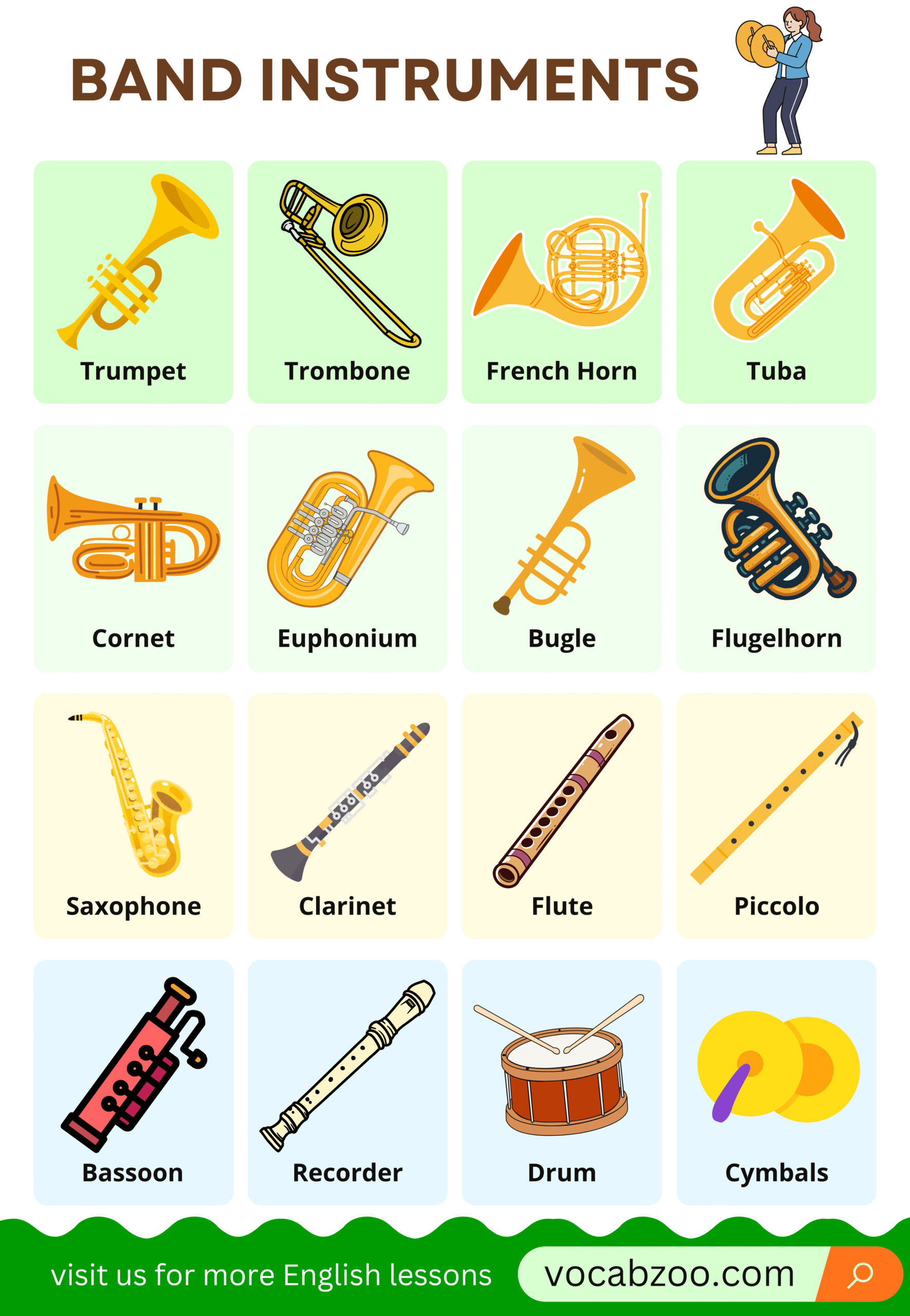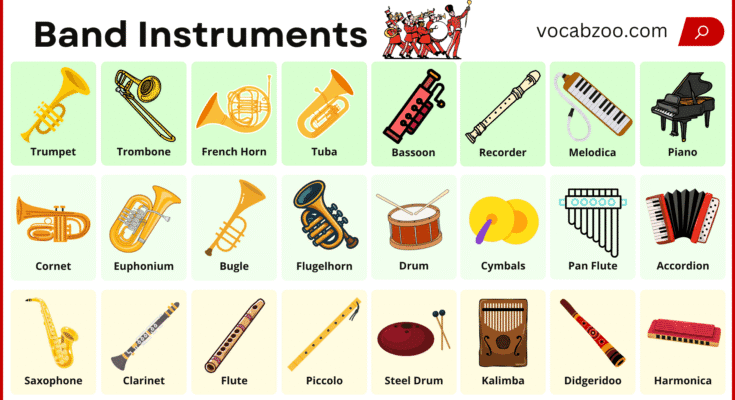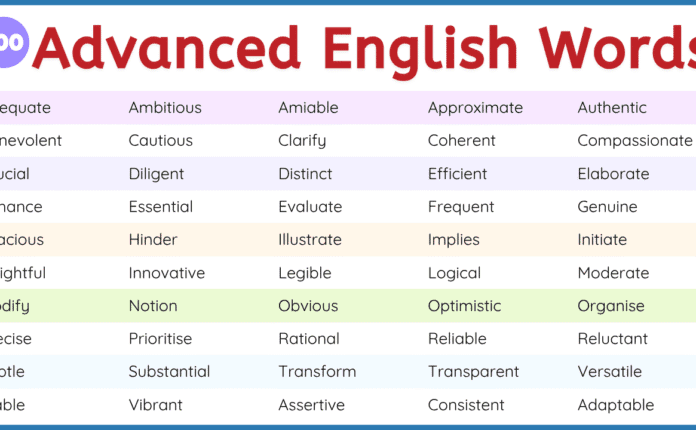Music bands bring joy, rhythm, and energy to our lives. From school bands to big concerts, band instruments create the melody that everyone enjoys. Each instrument has its unique sound, style, and purpose in the band. In this article, you’ll learn the names, uses, and pictures of common band instruments in easy and simple English.
What Are Band Instruments?
Band instruments are musical tools used by players in a band to produce music. Every instrument plays a special part — some make melody, others create rhythm or harmony. Band instruments are grouped into four main types:
| Type of Instrument | Example | Main Use |
|---|---|---|
| Brass Instruments | Trumpet, Trombone | Produce loud, bright sounds |
| Woodwind Instruments | Flute, Clarinet | Create soft, smooth tones |
| Percussion Instruments | Drums, Cymbals | Give rhythm and beat |
| String Instruments | Guitar, Violin | Add melody and harmony |
Band Instruments with Names and Uses
Let’s look at the most common band instruments and their uses:
Brass Instruments
Brass instruments are made of metal and played by blowing air through the mouthpiece.
Examples:
- Trumpet → Used in both jazz and marching bands for bright, high-pitched sounds.
- Trombone → Produces deep, smooth notes using a sliding tube.
- French Horn → Known for its warm, mellow tone in orchestras.
- Tuba → The largest brass instrument, gives the lowest pitch in the band.
| Instrument | Material | Sound Type | Main Use |
|---|---|---|---|
| Trumpet | Brass metal | Bright | Leads melody |
| Trombone | Brass | Deep | Background harmony |
| Tuba | Brass | Low | Bass section |
| French Horn | Brass | Warm | Orchestral blend |
Woodwind Instruments
These instruments are made of wood or metal and played by blowing air through a reed or hole.
Examples:
- Flute → Creates soft and high notes for melody.
- Clarinet → Known for smooth, flexible sounds.
- Saxophone → Used in jazz and pop bands for rich, expressive tones.
- Oboe → Makes a clear, strong sound in orchestral music.
| Instrument | Material | Sound Quality | Use |
|---|---|---|---|
| Flute | Metal/Wood | Light, airy | Melody |
| Clarinet | Wood | Warm, smooth | Harmony |
| Saxophone | Brass | Rich, loud | Jazz & pop |
| Oboe | Wood | Sharp, clear | Orchestra |
Percussion Instruments
Percussion instruments are hit, shaken, or struck to create rhythm and beats. They keep the tempo of the band.
Examples:
- Drum → Keeps main rhythm in all kinds of music.
- Cymbals → Add crashing sound for highlights.
- Tambourine → Gives light jingling rhythm.
- Xylophone → Produces melodic wooden tones.
| Instrument | Played By | Sound Type | Use |
|---|---|---|---|
| Drum | Sticks | Deep | Beat |
| Cymbals | Hands | Loud crash | Accent |
| Tambourine | Hands | Light ring | Rhythm |
| Xylophone | Mallets | Bright notes | Melody |
String Instruments
String instruments use vibrating strings to make sound. They can be played by plucking or using a bow.
Examples:
- Guitar → Common in all bands for rhythm and chords.
- Violin → Produces high, smooth notes.
- Cello → Gives deep, warm tones.
- Double Bass → Supports low sounds in orchestras.
| Instrument | Strings Count | Tone | Use |
|---|---|---|---|
| Guitar | 6 | Bright | Rhythm |
| Violin | 4 | High | Melody |
| Cello | 4 | Deep | Harmony |
| Double Bass | 4 | Very low | Bass support |
List of All Band Instruments
- Trumpet
- Trombone
- French Horn
- Tuba
- Cornet
- Euphonium
- Baritone Horn
- Bugle
- Flugelhorn
- Saxophone
- Clarinet
- Bass Clarinet
- Flute
- Piccolo
- Oboe
- Bassoon
- English Horn
- Recorder
- Drum
- Snare Drum
- Bass Drum
- Cymbals
- Tambourine
- Triangle
- Timpani
- Marimba
- Xylophone
- Glockenspiel
- Conga
- Bongo
- Chimes
- Drum Set
- Cowbell
- Castanets
- Guitar
- Electric Guitar
- Bass Guitar
- Violin
- Viola
- Cello
- Double Bass
- Harp
- Banjo
- Mandolin
- Piano
- Keyboard
- Synthesizer
- Organ
- Accordion
- Harmonica
- Bagpipes
- Ukulele
- Melodica
- Pan Flute
- Steel Drum
- Kalimba
- Didgeridoo

Band Instrument Groups and Roles
Each section of the band has its own role:
| Section | Main Role | Examples |
|---|---|---|
| Brass Section | Adds power and volume | Trumpet, Tuba |
| Woodwind Section | Provides melody and smooth sound | Flute, Clarinet |
| Percussion Section | Keeps rhythm and timing | Drums, Cymbals |
| String Section | Gives harmony and flow | Guitar, Violin |
Why Are Band Instruments Important?
Band instruments make music rich and expressive. Without them, music would lose its depth, emotion, and rhythm. They help musicians work together and create a complete musical sound.
Fun Facts about Band Instruments
- 🎶 The drum is one of the oldest instruments in history.
- 🎷 The saxophone was invented in 1840s by Adolphe Sax.
- 🎸 The guitar can be both acoustic and electric.
- 🎺 The trumpet can play more than 45 notes.
Band instruments are the heart of music groups. Each one has a unique purpose that brings beauty and balance to songs. Whether you love the beat of drums, the sound of a flute, or the strum of a guitar, learning about band instruments helps you understand music better and enjoy it more.
FAQs about Names of Band Instruments
What are the 4 main types of band instruments?
Brass, Woodwind, Percussion, and String instruments.
Which instrument is best for beginners?
The flute and drum are easy for starters.
What is the loudest band instrument?
The trumpet is one of the loudest instruments in a band.
Which instrument keeps the beat in a band?
The drum maintains the main rhythm and timing.
How many instruments are in a band?
It depends on the type of band, usually 10 to 25 instruments.
Read More



